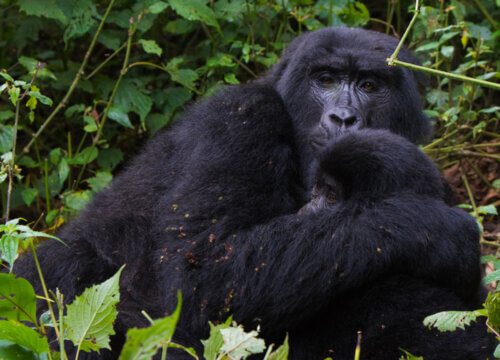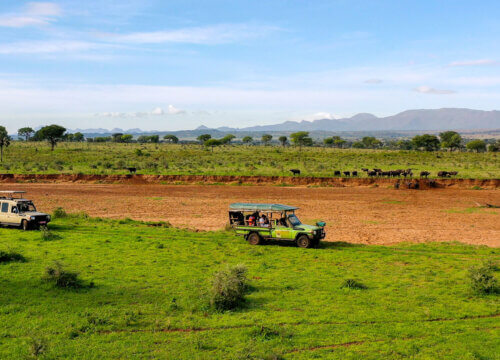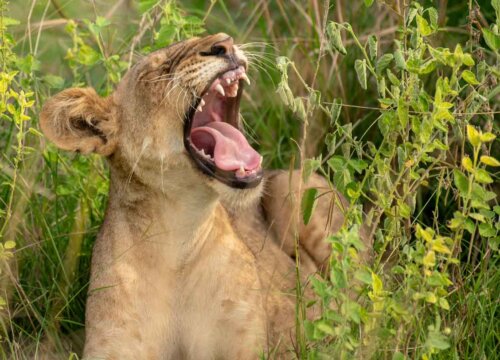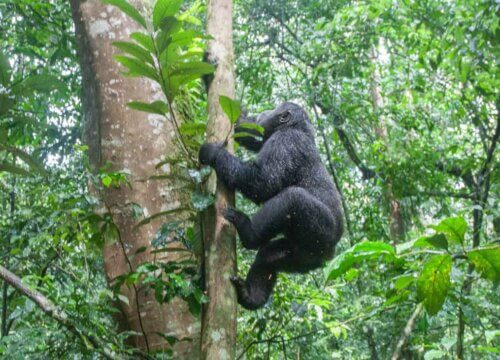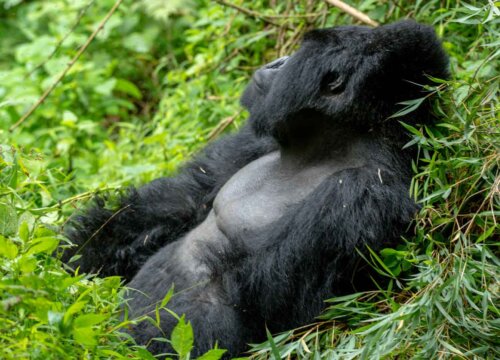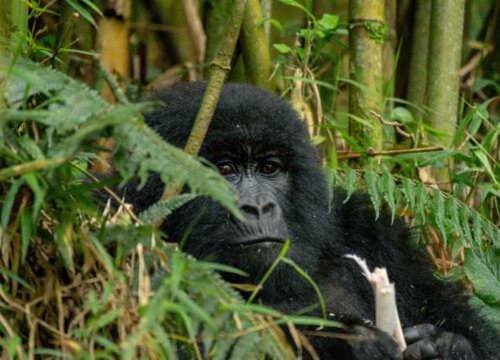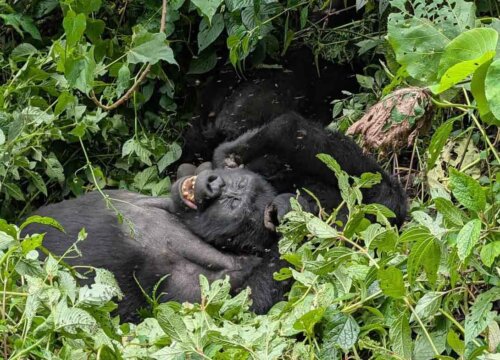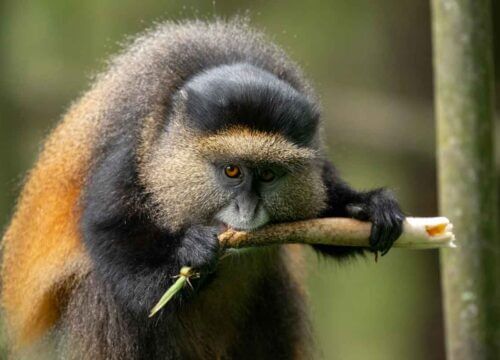Best time to see the shoebill stork in Mabamba Swamp Wetland
Best time to see shoebill stork in Mabamba Swamp
The best time to spot the shoebill stork in Mabamba swamp is early in the morning, usually between 7:00 AM and 10:00 AM. During this time, the birds are very active and are usually seen hunting for lung fish in the shallow waters of Mabamba swamp. The cooler morning hours also give you a more comfortable experience as you sail through the papyrus channels in a canoe because there is less fishing taking place. Shoebill sightings can happen throughout the year but the dry seasons which are from December, early February, June, July, August, September and January are the best because the water is calm. The reduced water levels during these months also make it easier to locate the birds as they are seen feeding from Mabamba swamp. Photography during the dry season is also easy because pictures of these birds can be taken from any angle.
Shoebill stork in Mabamba swamp
Mabamba swamp is located along the shores of Lake Victoria in Uganda. This lush wetland is internationally famous for its bio diversity and it is one of the best places in the world to spot the elusive shoebill stork which feeds on lung fish. Visiting Mabamba swamp usually begins with a canoe ride through its winding stations surrounded by tall papyrus reeds and the calm sounds of nature. As you sail through the water, you will meet a beautiful range of bird species from vibrant kingfishers and majestic African fish eagles to colorful malachite sunbirds. But the true highlight is catching sight of the ancient looking shoebill whose unique appearance and slow careful movements make it an interesting subject for bird enthusiasts and photographers.
How to reach Mabamba swamp for shoebill stork sighting
To get to Mabamba swamp, start by making your way to Entebbe which is about 40 kilometers from Kampala. From Entebbe, you can drive from Kisubi to Nakawuka then Kasenge and finally to Mabamba swamp. Driving takes approximately 2 hours.
Another option is taking a motor boat from Nakiwogo landing site across Lake Victoria to Busi island. You will then be assisted by a local guide who will lead you to Mabamba landing site. The boat ride is the most scenic and gives visitors a chance to enjoy the beauty of Lake Victoria before reaching the swamp. Once at Mabamba, you will need a guided canoe tour to cross through the papyrus channels. Local guides are experts at spotting shoebill stork and will help you get close without disturbing their home.
What guarantees seeing shoebills in Mabamba Swamp?
To guarantee a shoebill sight, it is best to visit Mabamba Swamp early in the morning. Shoebills are most active during these hours usually hunting for fish in the shallow waters since it is their daily meal. Hiring an experienced local guide to escort you on your birding tour is also important because these guides know the swamp intimately and can cross the maze-like channels easily leading you straight to the shoebill’s favorite spots. In addition, consider visiting Mabamba swamp during the dry season that is from December to February or June to August because this is when water levels are lower which makes it easier to see these birds. With the right timing, guidance and patience, you are guaranteed to see these famous birds in their natural home.
Is it safe to do birding in Mabamba swamp safe?
Mabamba Swamp is safe for birding because it is near a landing site with tight security. The area is well managed by local communities and conservation organizations which ensures the safety of visitors and the preservation of its unique ecosystem. Guided canoe tours are the primary way to explore the swamp and experienced local guides are there to help you in crossing the waters while coming across the interesting birds. Like any outdoor activity, a few safety measures are wise. For example, wear comfortable clothes, bringing insect repellent and staying hydrated. It is also a good idea to follow instructions from your tour guide to ensure a smooth and enjoyable experience.
Other birds to see in Mabamba swamp besides shoebill stork
Mabamba Swamp has more than 300 bird species which makes it an attracting destination for destination for nature lovers. Among them is the African jacana which is known as the “Jesus bird” for its ability to walk on floating vegetation. Another favorite bird is the colorful malachite kingfisher which has its brilliant blue and orange feathers darting over the water. You might also see the papyrus gonolek, a shy but beautiful bird with a bright red chest and black back that lives in the swamp’s dense vegetation. Keep your eyes open for the pied kingfisher, crowned waxbill, African fire finch, great white egrets, African marsh harrier, double toothed barbet and the majestic African fish eagle.
Where else to can I do birding in Uganda?
Uganda has more than 1,000 bird species. Mabamba Swamp is known for its iconic Shoebill storks but there are many other birding destinations across the country that you can explore. If you want to expand your birding trip beyond Mabamba, here are some other places to visit;
Bwindi Impenetrable National Park
Bwindi Impenetrable National Park is a paradise for bird lovers with more than 350 bird species including 23 Albertine Rift endemics that are hard to find elsewhere. The park has bird species like the African green broadbill, colorful great blue turaco, black bee-eater, regal crowned hornbill, the handsome francolin, Rwenzori batis, and Shelley’s crimsonwing. The park has lush forest trails that offer a peaceful and rewarding birding experience.
Queen Elizabeth National Park
This park is not only known for its wildlife safaris but also as a birding hotspot with more than 600 bird species. The many environments that range from savannah to wetlands make it an excellent location for spotting birds. Some of the famous birds you can spot include the majestic African Fish Eagle, the striking Grey Crowned Crane, Malachite Kingfisher, African Jacana and Black-headed Gonolek. Kazinga Channel and Lake Edward are particularly rewarding spots for birdwatching offering both waterbirds and savannah species like the African skimmer, pink-backed pelican and papyrus gonolek.
Kibale National Park
Kibale National Park is known as the primate capital of the world with more than 375 bird species including the green-breasted pitta, African pitta, and black bee-eater. The Bigodi Wetland Sanctuary, located just outside the park is an excellent spot for birding and offers a chance to see papyrus endemics like the white-winged warbler, Great Blue Turaco, The African Grey Parrot. Other popular species are the Black and white Casqued Hornbill and the Yellow-rumped Tinkerbird whose cheerful calls brighten the forest.
Murchison Falls National Park
Murchison Falls National Park is the largest national park offering a mix of savannah, riverine and woodland homes that attract a variety of birds. It has more than 450 species. These include the Goliath heron, Abyssinian ground hornbill and shoebill stork which is usually seen in the Nile Delta. A boat cruise along the Nile is an excellent way to combine birding with beautiful views of the falls. Do not forget to pack binoculars and a camera with a good zoom lens to capture birds in this large park.
Lake Mburo National Park
Lake Mburo National Park has more than 300 bird species and it is perfect for bird lovers who want to explore a variety of habitats in a smaller area. Lake Mburo is particularly known for its acacia associated birds like the bare faced go away bird and black bellied bustard. The park’s lakes and wetlands also attract water birds like African fish eagles and malachite kingfishers.
Semuliki National Park
Semuliki National Park is located in the Albertine Rift Valley. This park is home to more than 440 bird species for example Congo serpent eagle, Nkulengu rail, lyre tailed honeyguide, the Shoebill stock, the African Piculet, White-crested Hornbill, Black Dwarf Hornbill and Red billed Dwarf Hornbill. Semuliki National Park also has the Great Blue Turaco and the African Finfoot which can be spotted along the rivers and wetlands in the park.
Mount Elgon National Park
Mount Elgon National Park is another birding destination located on Uganda’s eastern border with Kenya. The diverse heights of the park provide habitats for a wide range of birds like Jackson’s francolin, Hartlaub’s turaco and the Tacazze sunbird. The park also hosts other birds like the majestic crowned eagle, African goshawk, African blue flycatcher and the white-starred robin.
Ziwa Rhino Sanctuary
Ziwa Rhino Sanctuary is primarily known for rhino tracking but it also has excellent birding opportunities. The sanctuary’s wetlands and woodlands are home to more than 300 bird species including the elusive shoebill stork, African grey parrot, Abyssinian ground hornbill, the Malachite, Pied Kingfishers and the African Fish Eagle. Guided birding walks are available to help you enjoy your visit. Other birds include the Great Blue Turaco, the Saddle-billed Stork and many herons which can be seen in the marshy areas.
Budongo Forest Reserve
Budongo Forest Reserve is located near Murchison Falls National Park and it is one of Uganda’s largest natural forests and a key birding location. The reserve has more than 360 bird species like puvel’s illadopsis, chocolate-backed kingfishers, white thighed hornbills, African Grey Parrot and the Yellow-crested Woodpecker. Additionally, you will meet the White-thighed Hornbill, a large bird often seen sailing through the canopy.
Mgahinga Gorilla National Park
Mgahinga Gorilla National Park is located in southwestern Uganda. The park is not only famous for its mountain gorillas but also for its bird species. Mgahinga Gorilla National Park has more than 180 bird species some of which are rare and endemic to the Albertine Rift region. One of the most popular birds in the park is the Rwenzori turaco with its exciting green and red feathers. Another highlight is the colorful Regal sunbird, the handsome francolin, Kivu ground thrush, dusky crimsonwing and the striking blue-headed sunbird. For those who enjoy forest birding, Mgahinga gives visitors chances to see species like the African olive pigeon, cinnamon-chested bee-eater and white-starred robin. Contact Giant Holiday safaris for more birdwatching destinations in Uganda
How long does it take to find shoebill stork in Mabamba swamp?
The time it takes to find shoebill stork in Mabamba swamp changes depending on the conditions within the day and the proximity of shoebill food. Usually, guided canoe tours through Mabamba swamp last about 2 to 4 hours and most visitors are lucky enough to spot 1 out of 12 shoebills in Mabamba swamp within this timeframe. The chances of success are high because experienced local guides know the shoebill’s preferred habitats and behaviors. Shoebills used to be many but were later killed by local people who called them bad omen. The competition of fish by fishermen and shoebill stork also leads to their death which reduces their number. For better views, consider early mornings because the shoebill is most active during this period standing still in shallow waters while hunting for fish. Patience is key but the reward of seeing this rare bird in its natural home is worth the wait. Do not forget to Contact Giant Holiday Safaris so that we plan your shoebill stork tour in Mabamba Swamp.
Is birding in Mabamba swamp difficult?
While crossing the swamp may seem difficult at first, the experience is made smooth and enjoyable by expert local guides. Most birding tours are conducted on traditional wooden canoes which makes sailing easy through the papyrus channels. The guides are skilled at spotting elusive birds and know the best areas to explore. The ground itself is calm and no tiring trekking or climbing is required. However, patience is required because some birds like the Shoebills require a bit of waiting to spot. You are advised to prepare comfortable clothes, Rain jacket, insect repellant, sunscreen and comfortable shoes in case of unexpected rain. These items also protect you against stinging insects from Mabamba swamp.
What to pack for a Mabamba swamp birding tour in Uganda
- Pack your binoculars to help you spot those rare birds hiding among the reeds.
- If you are into photography, pack a camera with a zoom lens to capture the beautiful residents of Mabamba swamp.
- Pack light and comfortable clothes with neutral colors like khaki, green or beige to blend in with the environment and not frighten the birds.
- Long sleeved shirts and pants protect you from the sun and stinging insects.
- Comfortable rubber boots or waterproof hiking shoes will keep your feet dry and comfortable throughout the tour since you will be exploring by boat or walking near marshy areas.
- Pack a wide-brimmed hat and sunglasses to shield yourself from the sun.
- Do not forget a sunscreen to guard your skin against sun burns.
- Bring an effective insect repellent to keep off mosquitoes and other bugs that live in Mabamba swamp.
- A first aid kit to treat small injuries.
- Carry a reusable water bottle to keep yourself refreshed while reducing plastic waste.
- Take hard cash for physical purchases.
- Beach wear for swimming at Ngamba island beach.
- A small notebook and pen are perfect for writing down notes about the birds you see, their behavior and any other memorable moments from your trip.
- A torch for light at night.
- Pack some light snacks to keep your energy up during the trip.
- A light jacket or raincoat is also a good idea because weather near the swamp can be unpredictable with surprising rain even during the dry season.
Explorer More Safaris
- 14-Days Uganda Safari Gorilla Chimpanzees and Wildlife
- 12 Days Gorillas and Chimpanzees Wildlife Safari
- 10 days best of uganda primates & wildlife safari
- 6 Days Gorillas and Chimpanzee Trekking Safari
- 3 Day Bwindi Gorilla Trekking Safari
- 4 Day Uganda Gorilla Trekking and Wildlife Safari
- 4 Days Gorilla Trekking and Adventure Safari
- 5 Days Uganda Gorillas and Chimpanzee Tracking Safari
- 4-Day Rwanda Gorilla Trekking and Golden Monkey Tracking Safari
- 5 Day Gorilla Habituation and Chimp Trekking
- 4-Day Uganda & Rwanda Gorilla Trekking Tour
- 3 Days Bwindi Gorilla Trekking Ugnada from Rwanda
- 10 Days Uganda Primates and Game Safari

